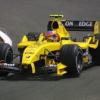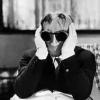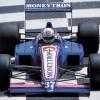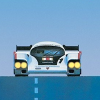Imagonna open this up a bit to perhaps the greatest pole in the history of the World Championship.
And it didn't come in a Formula 1 race. It didn't even come in a Grand Prix.
Hie yourself hence to Indianapolis, 1955, where the fabled qualifying is underway. The position is complicated. Cars are placed in order firstly by the date on which they qualified, and secondly by their speed. So you can be the fastest in the field, and start 33rd and last, if you are the only chap to qualify on the last day.
Conversely, you can be the slowest in the field, and start from pole, if you're the only chap who qualifies on the first day.
Bear that in mind.
You have up to 3 goes to qualify. You go out for practice laps. If you want a qualifying run, you let the chaps know (in this era, there are no chapesses, they are verboten from Gasoline Alley), go for a warm-up, and then, if you want to go for it, raise your arm. Take 4 laps and that's it. You've qualified.
Which is a problem if you are dog-slow. Because if 33 cars are quicker, you are out. And you can't hop back and have a second punt. Each car can only set one qualifying time.
So, if your first couple of laps are indeed dog-slow, you can wave them off. Pull into the pits. You don't record a time - but that's Strike One. You are allowed two. So on your third you have to complete regardless.
The upshot of this is that to qualify on pole you must qualify on the first day qualifying times are allowed. The only way you can if you don't is if nobody does.
So on Pole Day in 1955 you are probably getting a little annoyed. Because it's a bit windy. And nobody is going out. The old hands know that the wind will knock a few mph off the time.
Which is a problem for the Speedway. Because if nobody qualifies, they have to refund the spectator tickets.
Getting to closing time and nobody has gone out. The team owners have made a pact. Nobody will go out so everyone has an equal shot.
Thing is, nobody has told Jim Robbins about this. Robbins is so pro-Indy that he will leave a bequest in his will to enter a car in his name for a decade afterwards. His family have no chance of funding it so they carpet out their pit as a sort of executive box.
Robbins has a ropey old Stevens upright, a dinosaur in the days of lower-slung lay-down roadsters. Not had a sniff of success in the fifties. Driver Jerry Hoyt is only 26 but has a decent amount of experience - but no real success. The combo is not favoured.
Perhaps that's why nobody thought to include Robbins in the cabal. And perhaps someone from the 16th and Georgetown offices had had a quiet word with their mate Jim. Because, with a few minutes before the gun goes to end qualification, the maroon and cream number 23 is being pushed to the end of pit lane. Hoyt is going to give it a go.
And go he does. He manages to squeeze out four precarious laps. Everyone was tipping 140mph plus as being the minimum required to get in the field. He's only just there. But he has stuck in 4 laps, and it is a qualifying run. Hoyt is on pole.
And now comes the mad scramble. Tony Bettenhausen is the first to get going and he sets a blister of a lap - but cannot keep up his momentum. Second. By a scant 0.11 seconds over 10 miles. The popular Pat O'Connor got to 3rd in line but his first two laps are 138s and he is waved off. And that's it. Qualifying over. Jack McGrath will be the fastest man in the field - but he starts behind the day 1 qualifiers.
So Hoyt, a 100-1 shot, has nicked pole position. And, technically, for a year, he is the youngest pole-sitter in the World Championship.
Of course, he still had to be one of the 33 fastest, but conditions do not really improve. In fact only 9 will go faster than him.
Hoyt did not have time to enjoy his moment. He didn't lead the first lap. Indeed he wasn't even in the first three. By the time the race had 10 in the book he was already out of the top ten. McGrath sprinted into the lead for the first three, before Vukovich swept past. They diced for the first quarter of the race and looked to make it a classic. Then McGrath slowed, and pitted, mechanics wrenching out the spark plugs confirming he was out, leaving Vukovich clean and green, and heading for an unparallelled hat-trick.
And then that happened on the back stretch.
Hardly anyone had noticed that the pole-sitter was already out of the race. Oil leak.
The winner of the 500 was Bob Sweikert. He ran a sprint car team as well. Sprint cars were like Indy cars, only slightly smaller, and considerably more deadly. Hoyt was his team-mate. Two months after Indy, Sweikert and Hoyt had a go at a sprintcar race in Oklahoma. The dirt track was typically rutted and Hoyt was flipped by one of the holes. Back then the roll bar was the driver. Hoyt could not survive. In the final race of the year McGrath was also killed in a Champcar crash. And to complete the story Sweikert died in a sprint car crash a year and a month after his greatest day.







































